Build a Rental Platform with Us
Leverage our expertise to build a rental portal with intuitive interfaces and robust backend systems.
The coming year will offer many lucrative opportunities for those aiming to create a website for rental property, while digital solutions around buying and selling real estate might experience a tectonic drop. Here is why and how to create a rental marketplace platform in 2024.
A rental marketplace platform is an online rental marketplace where individuals or companies list vacant properties for rentals. The most popular online rental marketplace platforms are AirBnb (best for vacation rentals), Rent.com (best for first-time renters), Zillow (one of the best overall), etc.
Leverage our expertise to build a rental portal with intuitive interfaces and robust backend systems.
The popularity of rental marketplaces is set to rise in 2023 and 2024 as more and more people are holding off on buying a house in light of recent economic fallouts:
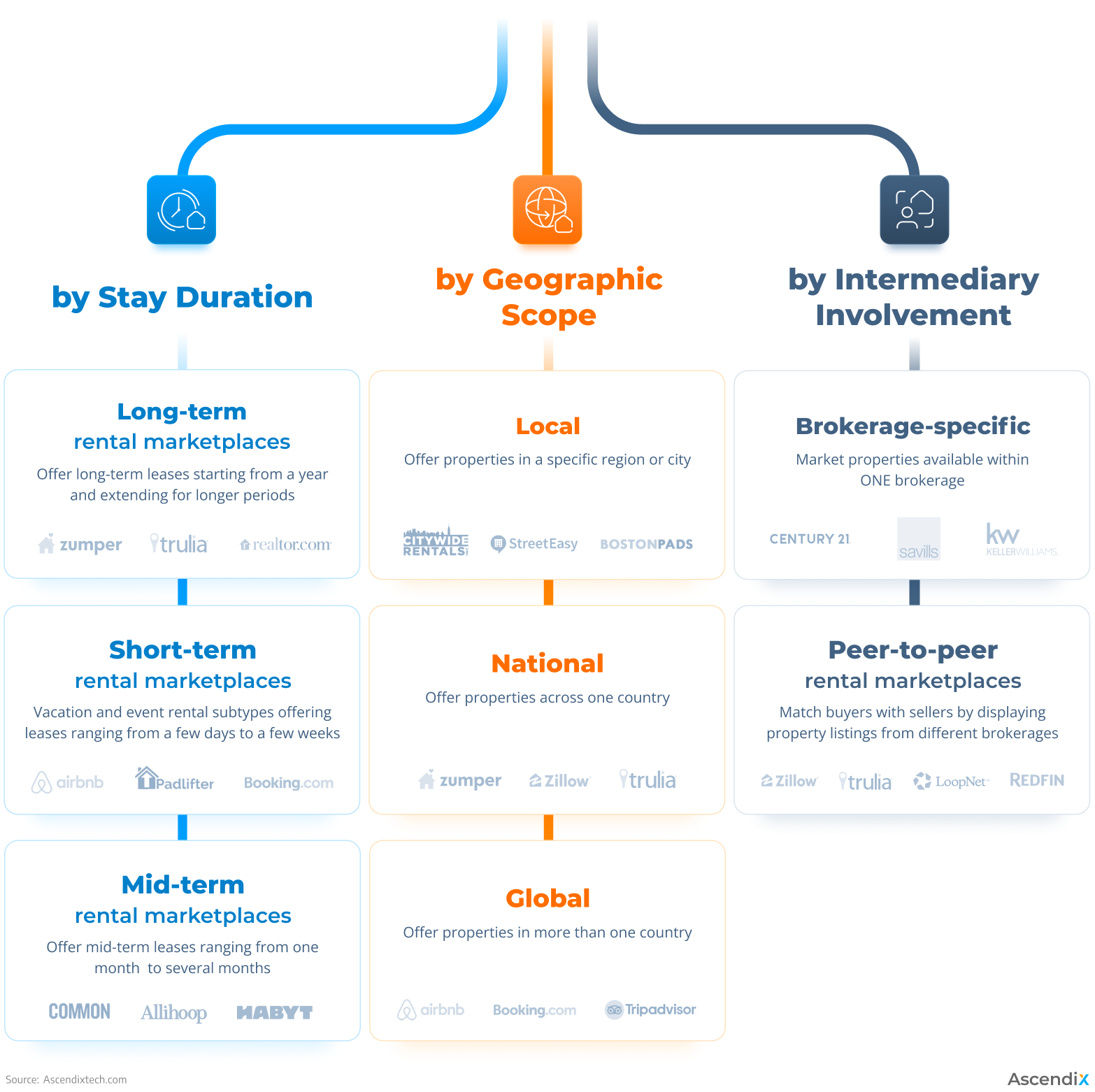
Types of Residential Rental Marketplaces | Ascendix
Residential real estate marketplaces cater to individuals seeking homes for personal use, while commercial real estate marketplaces serve businesses and investors in search of properties for running different business activities.
As mentioned earlier, we do think that in the year 2023 and 2024 residential rental marketplace platforms will be a hot commodity, much hotter than commercial ones. This is largely because of the current cost-of-living challenges, high interest rates, and the fact that many people simply can’t afford to buy their own homes, so they are looking for more affordable options. Rentals will be just that (in many cases, the monthly mortgage payments have aligned with monthly rents which has never been so before). This is why down below we’ll be focusing exclusively on residential rental marketplace platforms.
Marketplaces like Zumper, Trulia, Realtor.com, and Zillow offer long-term leases starting from a year and longer to individuals or families seeking a primary residence, students, and professionals relocating for work assignments.
Long-term marketplaces are associated with:
Marketplaces like Airbnb, Padlifter, and Booking.com offer short-term rentals, typically ranging from a few days to a few weeks, to ‘work’ travelers (for instance, you’re visiting a conference), tourists – short getaways or ‘weekend escapes’, conference and event attendees, short-term business travelers, etc.
Short-term rental marketplaces are typically divided into vacation and event rental subtypes.
Generally, short-term properties have the highest rental rates due to the highest demand on the market, but a vacation property will highly depend on seasonality. That’s why when building a short-term rental marketplace pay attention to the following functionality:
These marketplaces offer accommodations for periods typically ranging from one month to several months to digital nomads, teams engaged in middle-term projects related to a specific location (festival preparations, workshops), medical travelers, seasonal workers, individuals in transitional phases, etc.
Middle-term rentals are the least developed niche in the residential rental market due to the less clear demand, since a traveler would often associate a one-month stay with a short-term rental.
On top of that, property owners prefer long-term leases because of the revenue generation stability, and brokers avoid 6 and 9-month rentals, since they offer lower commission compared to one-and-more-year deals – hence, the underdeveloped middle-term rental market.
Brokerage-Specific – For marketing properties available within ONE brokerage (Century 21, Savills, Keller Williams Realty), i.e., branded marketplaces. The ultimate goal behind such websites is to generate an agent commission upon closing a deal;
Peer-to-peer rental marketplaces – For matching buyers with sellers by displaying property listings from different brokerages (Zillow, Trulia, LoopNet, Redfin, CREXi, etc.). These online rental platforms make money by selling subscriptions and targeted advertising to mortgage lenders, homebuilders, and rental property management companies.
When building the online rental marketplace functionality, you should consider the needs, motivations, and expectations of each user involved in the rental process. Also, keep in mind that your marketplace features will highly depend on the monetization models you choose.
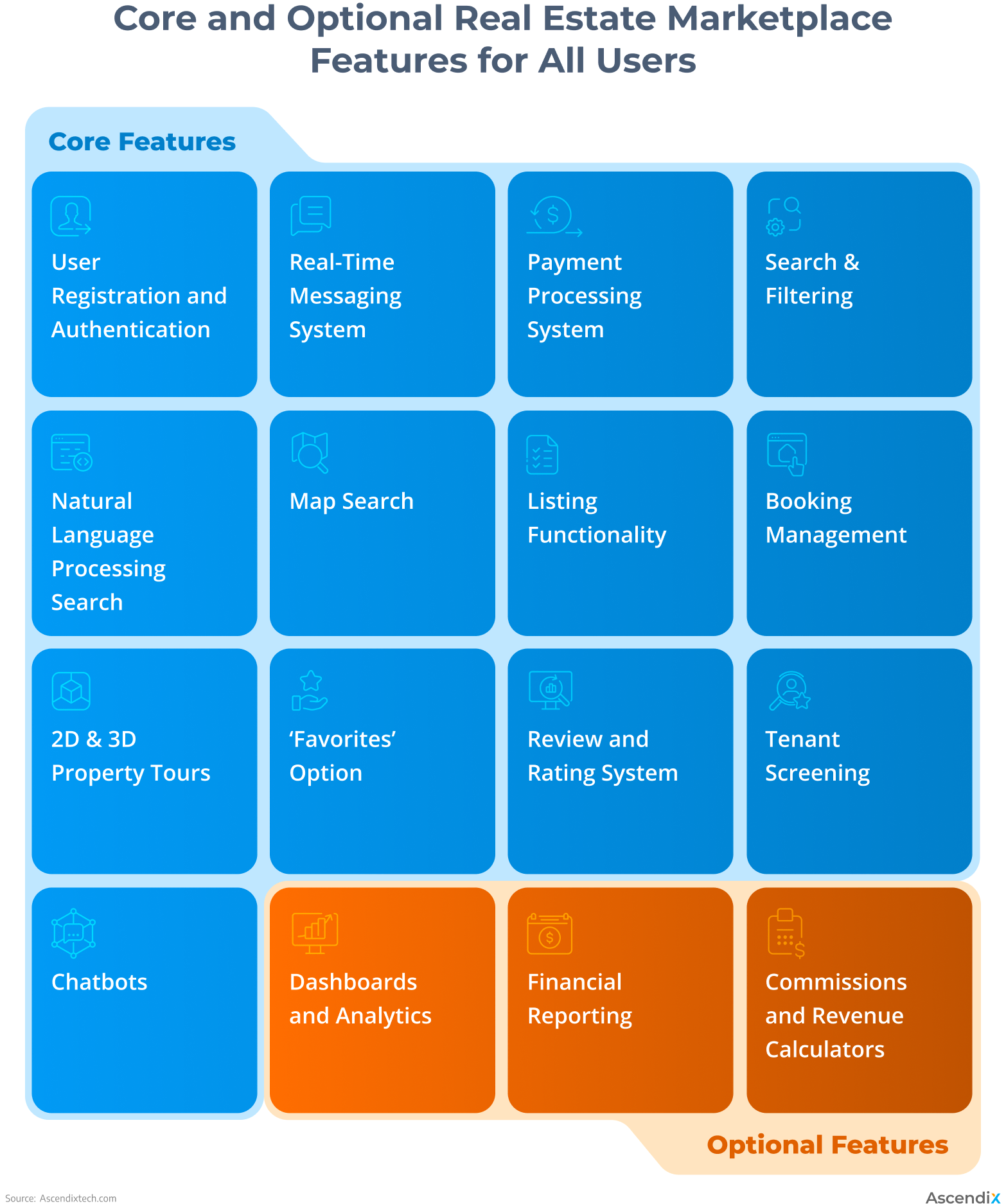
Core and Optional Real Estate Marketplace Features for All Users
Regardless of the business model you choose, all users must be able to create and customize accounts, add personal and property data without compromising its safety, log in securely (possibly with two-step authentication or email verification, and manage their profiles.
It’s important your system has Role-Based Access Control, according to which different access levels are assigned to users depending on their roles. For instance, tenants may have access to application and search features, while landlords – to property management tools and financial data.
Such a feature allows brokers and landlords to stay in touch with each other, provide timely updates, respond to inquiries from potential renters, and coordinate property showings.
A robust messaging system is vital for short-term rental marketplace platforms, since short-term renters are the most likely category to require immediate attention when it comes to booking accommodations. And if the landlord can’t address the urgent inquiries of their tenants in real time, there is a high chance they’ll lose a renter and rate your marketplace low.
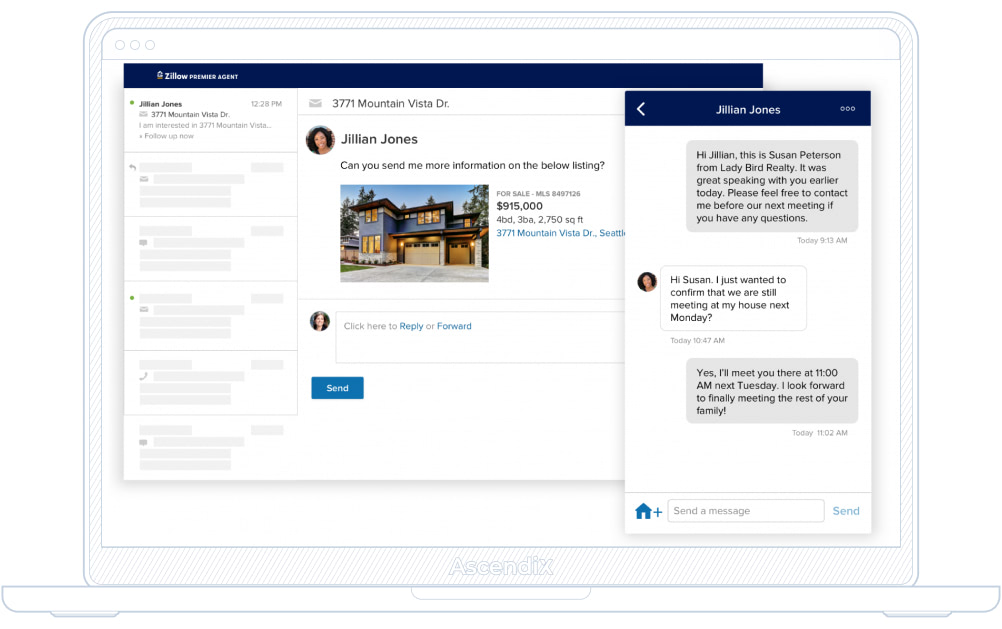
Zillow’s Messaging System
As for the mid-term rental property marketplaces, adding extended stay planning functionality might be a good idea so your guests can send you requests without the hassle of repeatedly booking shorter stays.
As for the long-term rental property marketplaces, the messaging system is supposed to have built-in maintenance report functionality, rent payment and lease renewal reminders. Oh, and don’t forget tenant screening. Landlords and renters should be able to securely upload and exchange documents.
The payment system should be able to process payments and service fees without delays (which is especially important for short-term rentals) and be securely integrated with third-party gateways like Paypal, Amazon Pay, and Stripe. Ensuring that your system comes with Escrow functionality where payments and deposits are held in trust until certain conditions (e.g., check-in) are met is essential, since it provides assurance to both renters and landlords.
But a payment system is not only about processing credit/debit card payments – it’s also allowing users to set their own extended payment schedules (for mid-term rents), set dynamic pricing (for short-term rentals, which depend on seasonality so much), generate and exchange electronic checks or financial reports, and also manage calculate and manage late fees (essential for long-term rentals). Additionally, your payment system might have automated rent collection functionality if you’re building a long-term rental marketplace.
Some marketplaces like Zillow (Zillow Rental Manager – a property management module) and Cozy might offer payment services like rent collection as an add-on module (because most often, the platform doesn’t manage such payments and the rent money is paid directly to the broker or the landlord), while other platforms like Booking.com collect the rent directly and transfer them to the landlords.
Advanced property searches with user-friendly interfaces and filters help renters find properties faster and more efficiently based on location, price, amenities, etc.
For tenants, the marketplace should offer user-friendly UI/UX design, especially if we’re talking about mobile apps, and should allow renters to conduct searches based on location, price, availability data, etc.
Meanwhile, brokers and landlords should be able to specify the listing and property type (short-term or long-term), set price ranges, specify property features, etc.
When your search engine is empowered with natural language processing algorithms (NLP), renters receive precise, comprehensive, and current property search results. For instance, Realtor’s Dream Home Builder is a property search feature that matches renters with their ‘dream’ properties by requiring users to describe their perfect house in the search field. In the end, an image of matching properties appears on the screen, along with a list of available listings users can choose from.
It should be noted though that this solution is only capable of searching solely by images and doesn’t fully recognize your natural language words as filters. To really make your rental marketplace’s search outstanding, you should implement AI that will be able to recognize everything you type in as actionable filters and apply those when searching on the map and making a curated list of best-matching properties.
Users can perform zip code searches or outline specific areas on the map to find properties within a designated distance. Some search functionality types also allow prospective tenants to access neighborhood data simply by clicking on the map. However, such a feature requires third-party integration with geolocation and property services like Google Maps.
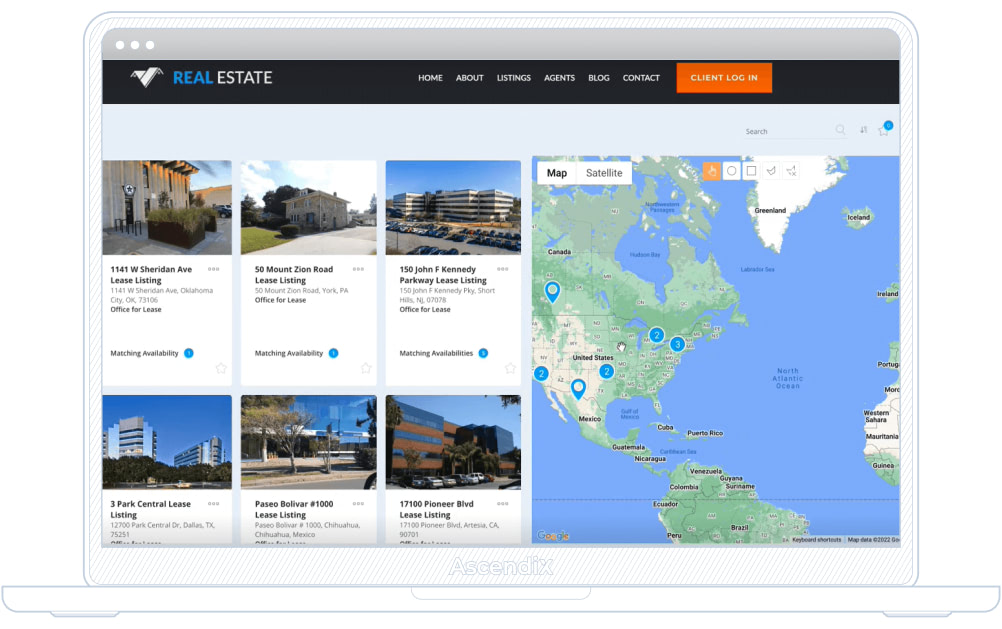
Marketspace Map Search
Often comes as a form that users must fill in with property details like price, neighborhood, number of bedrooms, etc. Depending on the business model of your real estate rental marketplace, you may choose to integrate your platform with third-party listing services, ie MLS to get up-to-date property listings in your area and publish them on your platform. Another possible integration is to link your system to other marketplaces to advertise your listings.
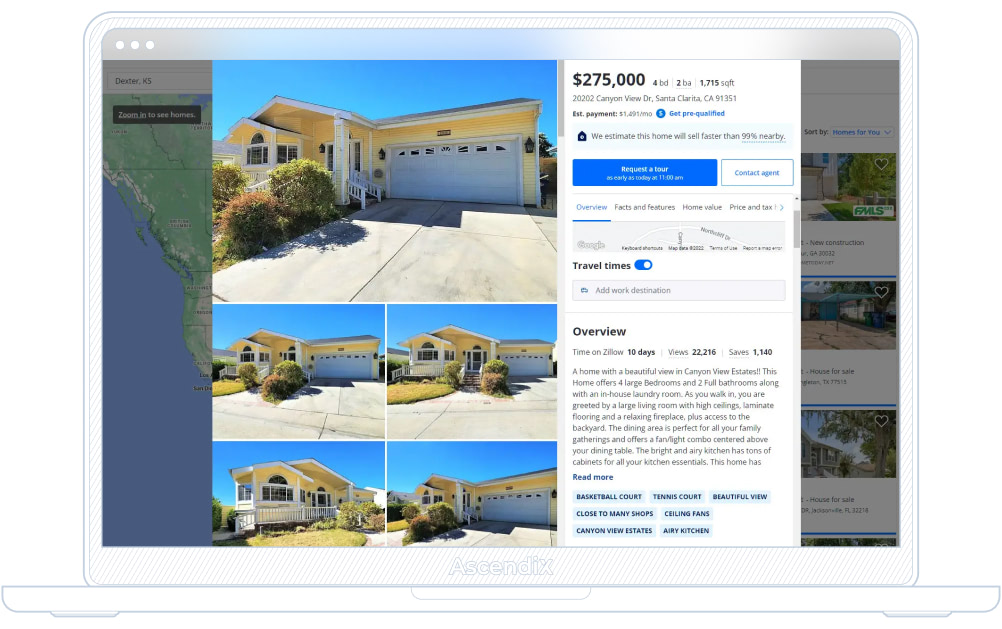
Zillow Listing Interface
We also advise you to create a listing management dashboard for brokers representing the landlords and managing the property listings on their behalf. Brokers should be able to legally access the platform at any time in order to create and edit listings, manage media (photos, videos, virtual tours), analyze the listing performance, manage financial transactions, and communicate with renters.
Some listing functionality might include AI-powered property listing generation. Brokers and landlords can generate property descriptions with all necessary details appealing to the renter. Most often, users use separate AI listing generation tools like Notion or Listing AI, but you can build such rental marketplace functionality directly as a part of your marketplace.
Users (landlords and brokers)- of short-term and mid-term rental property marketplaces should be able to receive booking requests on time, accept or reject them, and set availability calendars. Meanwhile, tenants should be able to view real-time availability and book properties in a few clicks.
If you’re not planning to build a property management functionality directly as a part of your marketplace, you can at least ensure your system integrates with property management platforms. For instance, marketplaces like Airbnb, Tripadvisor, and Expedia integrate with Hostaway, a cloud hotel management system for property managers.
2D and 3D property tours and floor plans help landlords and brokers market properties faster and allow renters to virtually explore the property, understand its layout, and get a feel for the space before renting it. For instance, Zillow offers a separate Zillow 3D Home Tour app to its users for free. With the app, brokers and property owners can easily generate interactive floor plans and 3D property tours.

Getfloorplan – AI Tool for Floor Planning
After saving a search or a specific property, customers can revisit it or resume from where they left off. This feature also allows customers to receive notifications when a property matching their search criteria becomes available on the site.
All renters have to do is click on the ‘heart’ or ‘star’ icon (like with Zillow or Trulia or so many other marketplaces) and the listing will automatically appear in the Favorites section.
Property owners should be able to receive property reviews of the tenants to improve the property performance. Users are commonly encouraged to leave reviews that might include photos, text, and videos once they complete their stay. Reviews are further published on the website so the future renters can know what to expect from the property. Higher reviews – higher chances that the property will be booked more often.
For instance, Playhouse Real Estate & Polls – a house searching portal that has brought community insight to a brand new level. Users can take polls and get a good grasp of what it feels like to live in the neighborhood or property they’ve chosen based on the reviews from former and current residents, property managers, investors, etc.

Playhouse Interface
For this purpose, marketplaces utilize an AI-powered sentiment analysis that by identifying and categorizing language patterns, keywords, and linguistic cues within the text data processes and evaluates user-generated content, such as reviews, comments, and feedback, to gauge the overall sentiment and emotional tone expressed by users.
Online rental property marketplaces like Airbnb don’t screen tenants, but if we’re talking about long-term rentals, such functionality becomes a must. Proper tenant screening (background checks, credit assessments, and rental history verification) helps landlords select reliable tenants.
But if you’re building a long-term rental marketplace, you should ensure your rental marketplace platform integrates with credit bureaus and systems that can provide brokers with tenant background checks. Other than that, your tenant portal should allow users to submit the required documents and track the request status, while landlords should be able to receive the reports and, in the end, make informed decisions regarding their tenants.
These can be simple FAQ chatbots or smart virtual AI-powered assistants that can handle customer requests 24/7, provide necessary information like property details, availability, and pricing, assist with property searches, and automatically book properties or schedule tours.
Considering that more than half of tenant inquiries come during after hours, having an AI chatbot that can handle inquiries 24/7 like a real-life broker would do is a must to retain renters. Companies like Zillow, Redfin, and JLL have introduced ChatGPT plugins that once installed, allow users to communicate with the machine and get accurate property recommendations.
What’s more, AI-powered tools can support multiple languages when powered with natural language processing (NLP), a useful feature for online rental marketplaces operating on a global scale.
With analytics tools, often powered by AI, property owners, managers, and brokers can evaluate property performance, occupancy rate, revenue generation, and make data-driven decisions. Meanwhile, travelers can access valuable insights into the availability of properties, pricing trends, and user reviews.
For instance, Zillow Premier Agent app allows users to generate lead reports, customer experience, ROI, and team reports. Brokers and property managers can gain valuable insights into their marketing efforts, lead generation strategies, and team performance.
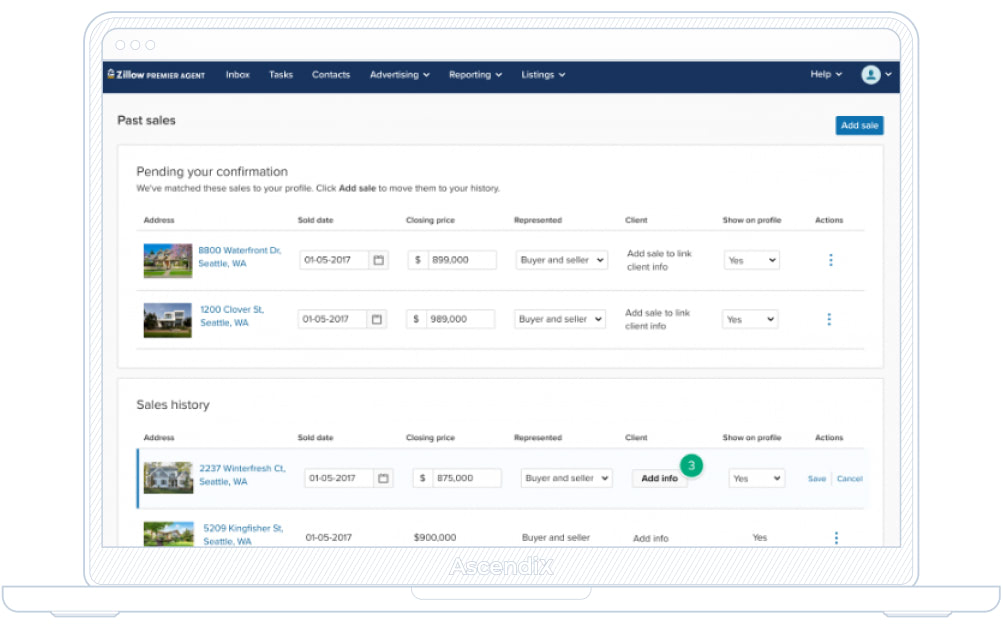
Zillow’s Premier Agent
This feature helps property owners and managers generate revenue reports and keep their property-related expenses in order. Though most often landlords use separate property management tools to manage their finances, some marketplaces offer in-built financial reporting functionality. For instance, Booking.com offers weekly, monthly, and annual financial reports that property owners can later download in PDF.
Brokers working on behalf of property owners can use a separate tool to calculate their commissions or perform calculations right within the platform functionality. Oftentimes, commission calculators support multiple currencies and can calculate individual & split commissions after a user fills a template with details like the property’s sale price, the commission rate, and any other additional fees.
The same goes for landlords who want to calculate their potential revenue. They can use separate tools like Rabbu for Airbnb profit calculation or built-in ROI calculators provided by marketplaces like Zillow.

AI Features for Residential Rental Marketplace Platforms
As it has been already shown on the example of Realtor’s Dream Home Builder in our article above, with the integration of natural language processing algorithms (NLP) into your search engine that understand the user intent and context, renters gain access to precise, all-encompassing, and up-to-date property matching results.
When integrated with systems like Google Maps, AI-powered interactive mapping offers geospatial data, such as property locations, neighborhood boundaries, public transportation routes, crime rates, and nearby amenities like parks and schools, so users can get a comprehensive overview of the property they’re interested in in a few clicks and without a need to visit external sources.
Using past data, AI in real estate can predict what prices and locations customers are likely to prefer. This helps brokers compare properties and set the right prices. For example, if a broker accidentally prices a property too low, the AI system can analyze similar properties and suggest raising the price.
If the renter has already used the marketplace, the system will store the customer historical search data and use it in the future to provide the renter with more accurate search results. For instance, if the user looked for rooms for non-smokers and hotels with parking lots – the future searches will consider the customer’s preferences.
This feature opens new opportunities to landlords who own multiple short-term and mid-term properties. Such an AI-powered system can predict which properties will generate the highest revenue based on seasonality criteria, historical booking trends, market demand patterns, and property features.
For global-scale marketplaces, such a feature is especially important, as they cater to customers from diverse backgrounds and regions. With AI-powered automated translation, a customer can fill in the application form in Italian, and a broker or landlord will seamlessly receive it in their preferred language.
Let Ascendix help you integrate advanced artificial intelligence solutions to stay ahead in the competitive landscape.
Marketing for mere user acquisition is not enough if you don’t know how to manage your leads and nurture relationships with them. No lead turns into a loyal customer without consistent engagement and timely follow-ups.
That’s why a CRM system automatically stores your user data and helps you maintain detailed records of interactions with your customers, set follow-ups, and track communication history. This means you can keep track of important dates, such as lease renewals or move-in/move-out inspections, ensuring that no crucial detail slips through the cracks.
Other than that, CRM offers centralized storage for your property contracts and agreements, so you can access it whenever you need it and reduce the risk of document loss.
Smooth integration with payment systems like PayPal ensures secure online payments, security deposits, and service fee transactions.
Smart integration with background check services like TransUnion, credit bureaus and criminal background check systems is vital for guaranteeing accurate tenant screening.
Most landlords manage their properties by themselves or delegate the task to the third party, so ensuring your rental property marketplace integrates with a property management tool like Appfolio or Buildium will provide seamless management of property-related tasks and possibly extra revenue streams because you’ll be offering this as a service.
When your rental marketplace platform is integrated with geolocation and mapping services like Google Maps, users get better search experience, since they can find properties based on location, distance, and amenities faster.
Whether you’re a fan of social media or not, rumor has it that Facebook and Instagram are expanding the platform’s reach and user engagement.
Integration with analytics platforms like Google Analytics can help you get insights into user behavior and platform performance.
The surge in demand for rentals creates a perfect storm of opportunities for those looking to create a website for rental property. In particular:
In fact, 9 out of 25 top Proptech companies in 2023 in the US are in some way or another focusing on rental marketplace software, with a clear indication for further growth of this trend.
There are at least three actionable models of monetizing a rental marketplace platform. However, remember that an average rental marketplace monetization model is a smart combination of different approaches we’re going to talk about.
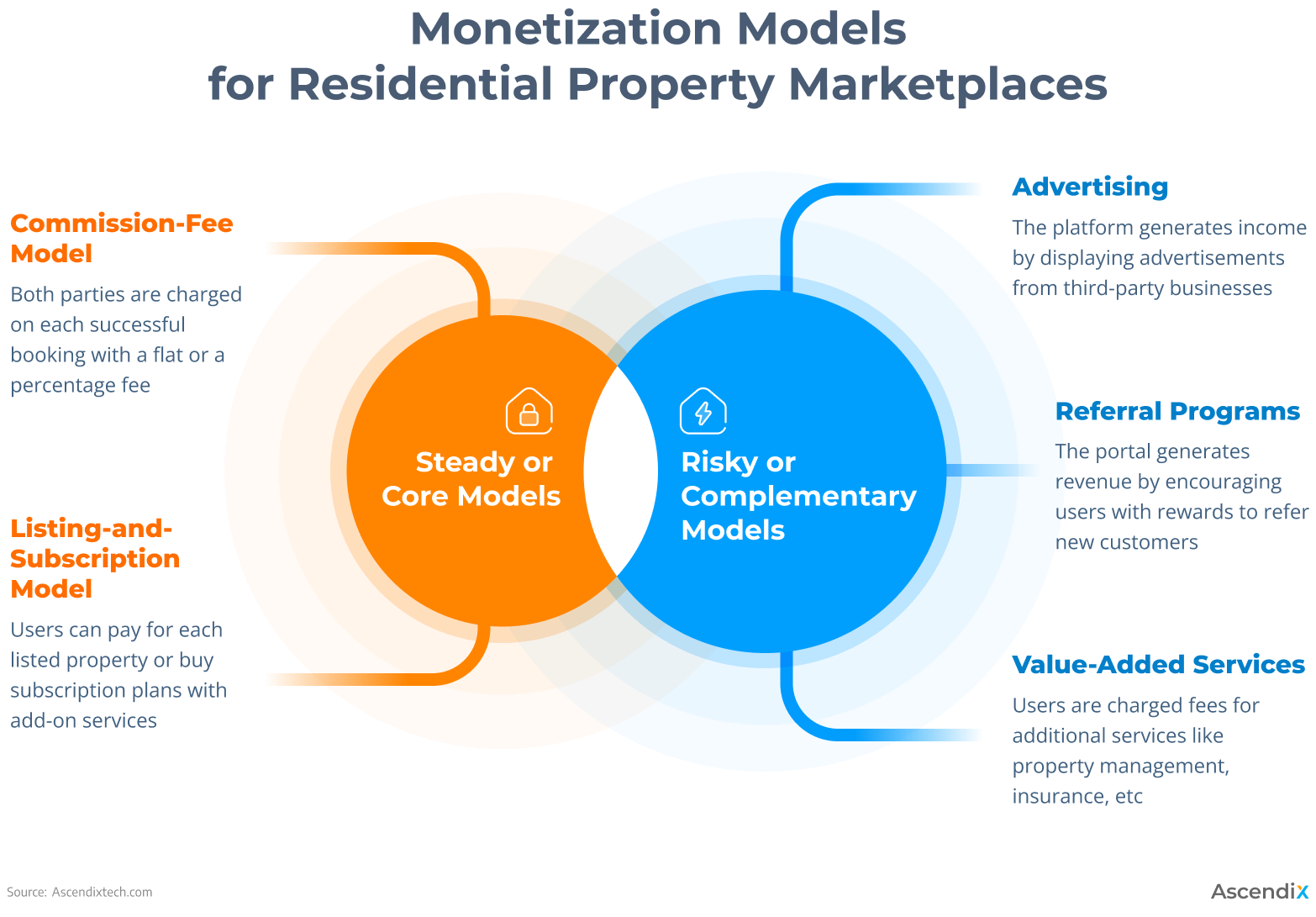
Monetization Models for Residential Property Marketplaces | Ascendix
We’d like to divide monetization models into steady and risky.
Steady models are associated with higher ROI that can be later reinvested into user acquisition, platform functionality improvements, and platform marketing.
Risky models are rarely applied alone, therefore often come as a complementary approach that helps a company grow their revenue.
Listing models imply one-time fees when landlords or brokers pay for each property listed on the platform. Meanwhile, a subscription model solely is based on subscription fees – users buy subscriptions and can list a limited (or limitless depending on the subscription plan) number of properties.
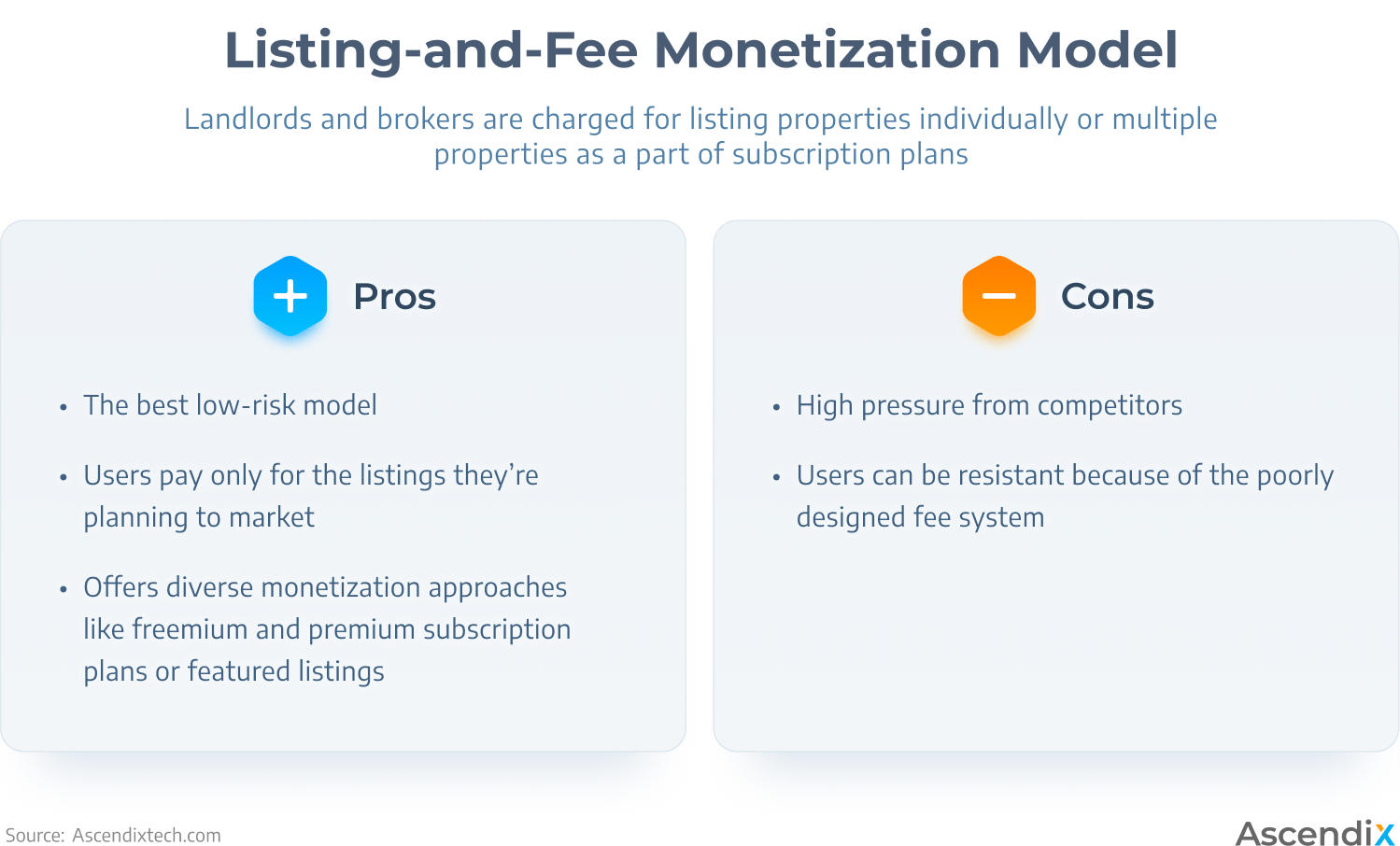
Listing-and-Fee Monetization Model | Ascendix
And while a subscription model often covers costs of customer support and verification processes, a pure listing model may ask for add-on fees on the latter, turning the entire business into a mixed marketplace model. For instance, companies like Zumper and Rentberry allow users to list their rentals for free but offer additional subscription services like Zumper Pro and Rentberry Plus: the former offers listing promotion services and lead management tools for a monthly fee, while the latter provides features like video tours and online lease signing for a monthly fee as well.
Such a marketplace requires advanced listing and subscriber management functionality, so landlords can efficiently showcase and market available properties, streamline the application process, and effortlessly change & manage their subscriptions. And don’t forget about the robust notification functionality because once a new listing matching the renter’s criteria is posted, they should be able to receive instant alerts.
On top of that, a listing-and-subscription fee model can be built with a featured listings functionality as a part of the monetization scheme. Featured listings are defined by higher visibility (they appear at the top of the search results and are marked differently) and allow landlords and brokers rate their properties higher and rent faster. Companies like Rent.com, HotPads, and Rentberry allow property owners to purchase “Featured Listings” to enhance the visibility of their rentals.
And if you’re happy with the performance of your listing-and-subscription-fee model, you can add a Freemium approach, categorizing your packages as free or premium. For instance, a user can list a higher number of properties with a premium package, a limited number with a free package, and limitless listings with a freemium one.
Our wrap-up: A pure form of monetization model is rare. More often, you’ll find a rental marketplace platform that utilizes a listing-fee model with subscription plans and coming with feature advertising or freemium options.
Such an approach ensures steady income, but you might have to deal with competitive pressure and user resistance. Some subscription models can be more effective than others, so it may take time for the marketplace operators to build well-balanced subscription models that bring revenue and are fully ‘affordable’ to users.
This type of property monetization model is most popular among short-term rental marketplace platforms in the hospitality industry, e.g., AirBnb or Booking.com. The platform charges users on each successful booking whether with a flat fee or a percentage fee calculated on the total ‘purchase’ price which equals the rent to be paid and the number of days a renter is going to spend on the property.

Commission-Based Monetization Model | Ascendix
The perfect example of a company that has applied a booking-fee model is Airbnb where renters pay a service fee of 14% for each successful booking, while landlords are charged a 3% fee. Another example is FlipKey, a subsidiary of TripAdvisor and a vacation rental property marketplace, that charges renters an 8-16% and hosts a 3% commission.
The heart of such a monetization model when it comes to the technical side is booking/commission functionality. Users should be able to see real-time availability, book properties with confidence, and complete transactions effortlessly, all while ensuring that landlords receive their earnings securely and promptly. And for the latter to happen, you need functionality like instant commission calculators and a payment processing system that is integrated with secure payment gateways & escrow systems and helps landlords handle refunds efficiently and fairly, should the need arise.
Our wrap-up: A commission-fee model offers pricing transparency, steady income for the hospitality rental marketplaces; higher revenue with percentage-based fees compared to flat fees. However, pay special attention when building the payment processing functionality so the payment transactions aren’t lengthy and complicated to users.
Hosts benefit from the fees shared with the renters, but the latter can be sensitive to additional fees. High transaction fees can deter users from using the platform or result in negative reviews.
Online rental marketplaces can gather revenue from advertising partnerships, but such a model becomes unreliable if a company fails to attract the required number of partnerships that can draw more revenue.

Advertising Monetization Model | Ascendix
As for the functionality, such a model requires ad management and reporting functionality so property owners and brokers can manage their ads, promote them and analyze the performance of ad campaigns.
Because the model is so risky, we advise you to combine it with other monetization approaches. Learn from the greatest: Zillow generates revenue by selling advertising space on Zillow.com and its mobile app to property management companies looking for tenants, real estate agents seeking buyers and sellers, as well as mortgage lenders in search of borrowers. But pay attention that this is not their main revenue model – the company is also a licensed lender, a property development entity (it buys houses directly from owners and resells them later after renovation), and a provider of Premier Agent Program – a subscription service for real estate agents who want to promote their properties smarter and contact potential buyers/renters directly.
Referral programs never come solo. They are a part of bigger monetization models like listing-and-subscription, adding an extra layer of value for users.
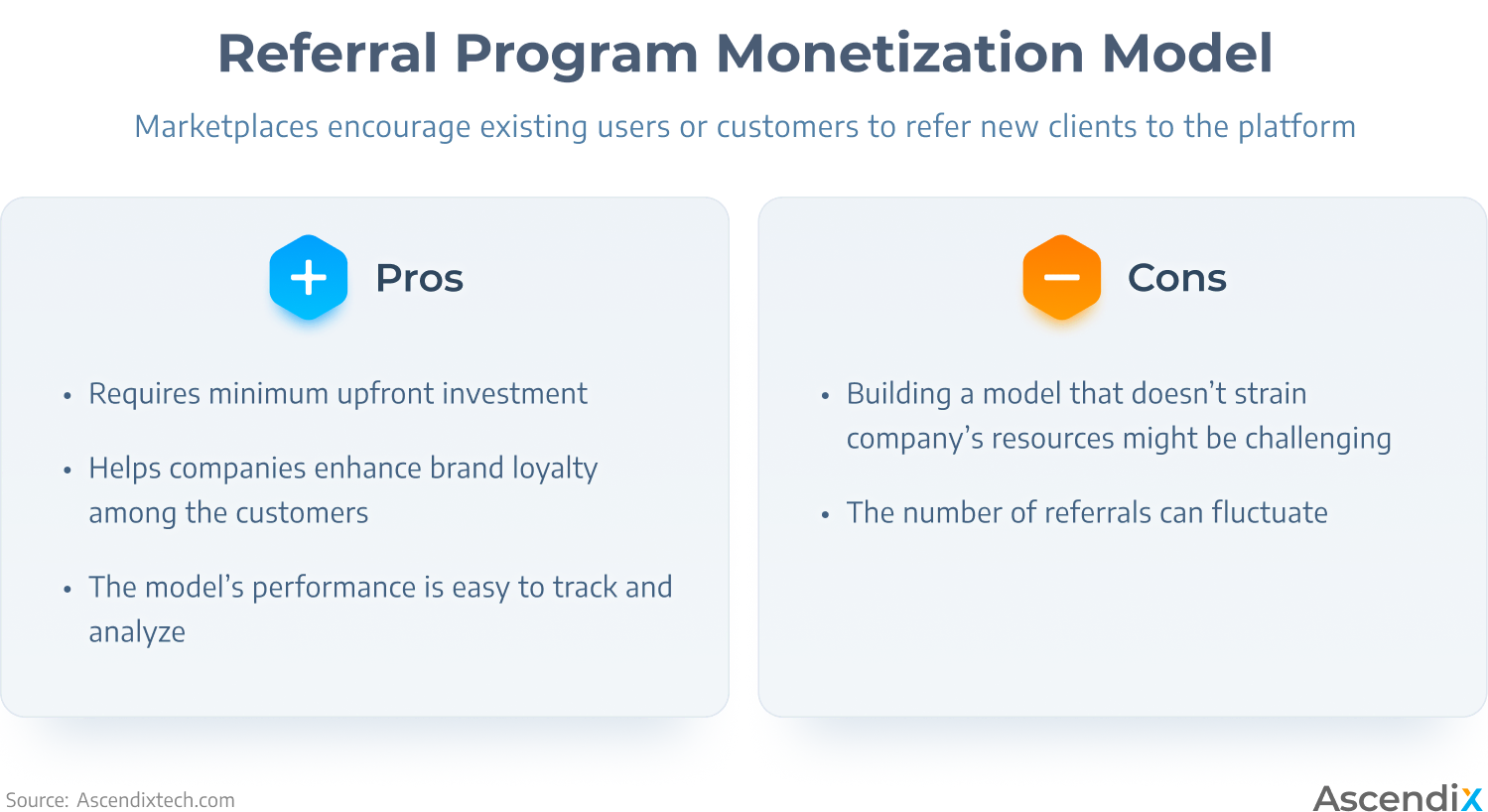
Referral Program Monetization Model | Ascendix
Users (both landlords and renters) can get special benefits and discounts each time they refer rental marketplace services to others. Sure, such an approach is great for improving user acquisition. However, it is highly dependable on the effectiveness of the program’s perks. Again, building a website business rental model that doesn’t strain the company’s resources is a must and can be a challenging task.
If you decide to add such a monetization model, a referral tracking system is a must to track clicks and conversions from referral links, which, by the way, your system should be able to generate. Additionally, all users should be able to monitor their referral earnings and redeem them in their user accounts.
For instance, RentRedi offers $50 to landlords who share referral links with other property owners. Once a new user is registered, and the link is approved, a user can enjoy their reward and even use it to get $50 off their annual plan.
Some marketplaces offer services for landlords like property management, tenant screening, or insurance. But before listing their properties, there is a high chance a landlord has already started cooperating with property management companies and might not need such services.
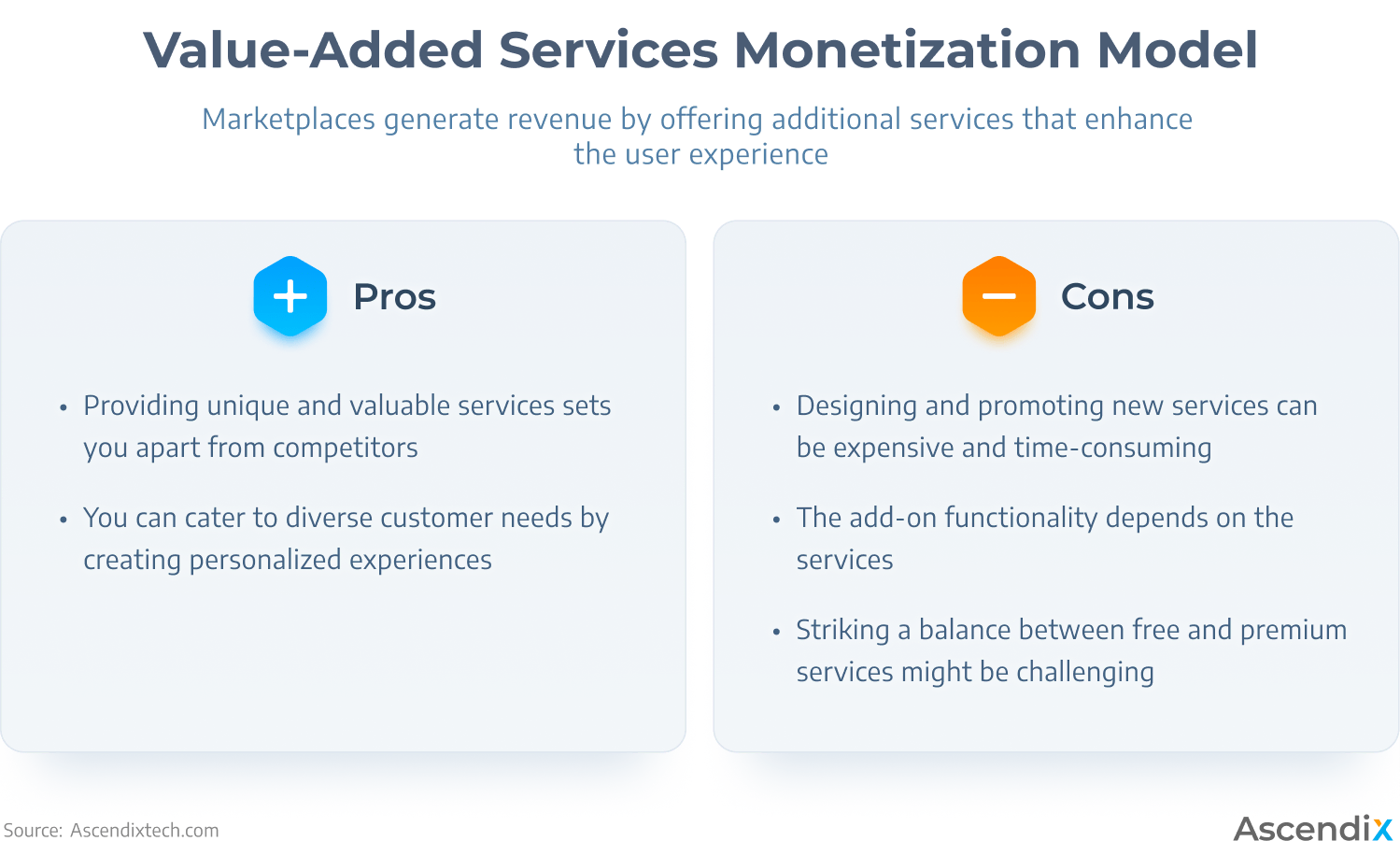
Value-Added Services Monetization Model | Ascendix
Yes, a value-added model is a great monetization idea, but it needs proper target marketing, especially considering that such services are most popular on the short-term rental market, so applying it to other markets might be difficult if not impossible.
The functionality for value-added services will differ depending on the actual services you choose. Let’s say it’s rental insurance. Apart from the fact that you’ll have to find a rental insurance company-partner, you’ll also have to build a rental marketplace functionality that allows users to browse the insurance plans, compare them side-to-side, and purchase them directly through the platform.
Meanwhile, a good example of a company that has included a value-added service into their core monetization model is Rentberry. The company offers tenant screening where it’s free for landlords, but tenants must pay $40 for credit reports and background checks.
We speak real estate. We’ve been developing software products for real estate for 2 decades. Speak to Ascendix consultant.
Once you’ve chosen the real estate rental marketplace type, the monetization model, and the features your future marketplace will include, the next crucial decision lies in how you build your rental marketplace platform.
Generally, there are two main ways to create a website for rental property:
Creating your rental marketplace from the ground up can be a viable option if you require advanced features or significant customization. This approach requires a significant amount of time and resources, but the advantages you get in the end are simply incomparable.
The key benefits of custom development include the following:
If you feel overwhelmed by technical jargon, integrations, and compatibility concerns, consider partnering with a technology company with experience in the real estate industry to guide you through the process.
By assembling a team of skilled professionals, including UI/UX designers and engineers, you can ensure a smooth launch and ongoing support for your product.
Utilizing a pre-existing solution can be a great option for small to medium-sized businesses that don’t have the resources or desire to make large initial investments or implement significant customizations.
With a no-code rental marketplace tool, businesses can quickly launch their ideas without a tech team, which is a significant advantage over costly custom development. These tools typically include pre-built features such as payment gateway, listing management, and user accounts.
However, as your business grows and expands, the need for additional functionality may arise, and no-code tools may not have the technical capabilities to accommodate these needs due to limited customization options.
Even if they do, the final costs may be even higher than building a custom solution from scratch, as these simple, non-technical platforms do not allow for any amends in the application’s source code.
Developing an online rental marketplace from scratch will take a lot more time and money than getting ready-made rental marketplace platforms.
An average of $10,000 to $25,000 (with $40 per hour as the service charge) will cost to develop an online rental marketplace from scratch. These numbers will largely depend on the complexity of your project and the development rates of your tech team, so it makes sense to consider all development options, including outsourcing and offshoring, to optimize your costs.
We’ve outsourced to 7 countries before we found a perfect solution, so make sure you run thorough market research before launching your project.
A Minimum Viable Product (MVP) is the initial version of your product that has enough features to appeal to early adopters and validate your idea but does not include any unnecessary functions.
Creating an MVP for your real estate marketplace platform can assist you in:
There is a significant difference between an MVP and a fully-featured real estate marketplace. An MVP focuses on validating the target audience, while a fully-featured product is designed to serve a specific target group.
The cost of an MVP is lower compared to a fully-featured product, but it should not be considered a raw or poorly-made product. An effective MVP should be a high-quality application, containing only the most essential features that can address the users’ most critical problems.
Having a successful MVP can reduce the time and cost required to create a rental website with a full set of features. It also allows you to present the app to a validated, loyal audience.
Before you start building a marketplace startup, check how other players built their website rental business models and rental marketplace functionality.
Year: 2020
Location: Stockholm, Sweden
Type of Rental Experience: Shared living spaces
Target Audience: Immigrants, travelers, individuals in need of flexible living
We’d like to call Allihoop a property development company for Millenials and GenZs who prefer flexible living and don´t mind sharing their space with others.
Allihoop has introduced a brand new concept in real estate as a solution to the home crisis for younger generations in Europe. The company cooperates with landlords in the Nordic region and invests in their properties by renovating and later renting them to the Allihoop community and managing them on behalf of the landlord. The company is interested in long-term cooperation (sublet contract, master lease, management contract, hybrid lease) – 15 years on average, which as a concept ensures stable revenue generation and protects Allihoop from economic crises.
To access the platform, one needs to apply for membership – yes, you can’t browse the platform as you’d do with Realtor.com or Zillow. But if you contact the platform, and your application is accepted, you can browse the properties and choose the ones you like.
All core operations are managed through the platform – landlords and renters can safely exchange the documents, sign rental contracts and pay an add-on partner fees, safely secure deposits through the platform and send flexible notice periods requests if they decide to stay longer.
The company is managing 500 properties in different locations in Stockholm and renting them with a community approach. Calling their short-term, mid-term, and long-term tenants Go-Getters, Allihoop offers not only shared spaces to them but also community events such as yoga sessions and parties as a part of their community culture.
Currently, the company is planning to expand its business operations to Copenhagen and Gothenburg.
Year: 2015
Location: New York, US
Type or Rental Experience: Coliving spaces, microunits
Target Audience: Digital nomads, mid-term travelers, community-seeking individuals
As a startup, Common has implemented the same business model as Allihoop did. The company offers shared living for everyone in need of mid-term and long-term rentals along with community experience (leases are 3+ months, and the minimum deal size is 100+ properties).
The company operates in cities like New York, Baltimore, Chicago, Berkeley, etc. It also has its very own Common Studio, an in-house design firm that optimizes Common´s properties and offers home design services to other real estate players as well.
As Common states, they design and lease multifamily properties while also ensuring top property management services to their tenants. Yes, you no longer need to worry about plumbing or cleaning expenses when paying your ´Common´s´ rent.
Unlike Allihoop, Common allows unregistered users to browse the marketplace by setting criteria like ‘price,’ ‘lease length,’ ‘budget’ and enjoy the robust interactive map search functionality. By clicking on the property, users get access to the basic property details, check the floor plans and 3D tours and learn more about the neighborhood where the property is located. Further, you can apply for the property or request a tour.
It also includes property management functionality, so once you start cooperating with Common, you can forget about the need to use external property management software, or you can opt for the property management services provided by the Common team.
Year: 2015
Location: Barcelona, Spain
Type of Rental Experience: Flat-sharing, room and apartment rentals
Target Audience: Digital nomads, mid-term travelers, community-seeking individuals
Badi offers all-inclusive private apartments, suites, or rooms in fully furnished homes in Barcelona, Madrid, Valencia, and other Spanish cities for mid-term and long-term renting (6-11 months and 12+ months respectively). Depending on the property type you’ve chosen, the price will differ.
Just like with Allihoop, you can check the profiles of your future ‘suitemates’ and learn more about the community life before booking the property. And to find a suitable property, the marketplace offers you a search map where you can click on the property and get all the details you need. You can also start chatting with the property owner if any questions occur. But bear in mind that Badi marketplace doesn’t have chatbots, so there is a range of hours when you can’t reach the team. Once you’re accepted as a community member, you’ll get a communication channel to learn more about news, events, and Badi guests.
Online Concierge, room cleaning, community events are all a part of the rental package with services and bills included.
Year: 2017
Location: Berlin, German
Type of Rental Experience: Shared and private living
Target Audience: Immigrants, travelers, individuals in need of flexible living
Habyt operates 30 0000 properties globally in 25+ top cities like Lisbon, Paris, Barcelona, Turin, and others, offering both shared and private living experiences in North America, Europe, and Asia. Compared to Badi, it provides a variety of affordable accommodations in different price ranges.
The company has its own property management team that can deal with property management tasks on the landlord’s behalf. With technology & automation combined with a flexible business model that improves density, hence helps landlords generate more income, Habyt promises 10+ years stable income.
Just like Badi and Common, Habyt allows unregistered users to browse properties, get the basic details, interact with the map, and check similar properties which the system offers based on your search criteria. The marketplace functionality ensures users can manage payments and requests in their accounts (Habyt app and Habyt Member Portal) and reach Habyt’s support team when needed. No opportunity for booking individual property tours is the only drawback; and because Habyt offers mid-term properties, you can’t book the property you like, but should apply for it first.
Year: 2015
Location: Bengaluru, Karnataka, India
Type of Rental Experience: Long-term and mid-term rentals
Target Audience: Immigrants, individuals looking for affordable mid-term and long-term rental experience
NestAway offers affordable rental options in various Indian cities such as Bangalore, Mumbai, and Belagavi, with a minimum stay period of 6 months or longer.
The platform provides users with verified self-guided property tours, allowing them to save time and explore properties at their convenience. There’s no need for brokerage assistance when renting properties, whether it’s apartments, bungalows, villas for families, or accommodations for groups of friends. Additionally, the company offers shared or private rooms for those seeking individual experience.
NestAway caters to diverse rental needs, but what sets us apart is their commitment to customer satisfaction. The platform offers instant deposit refunds and provides enticing loyalty programs. For example, renters can enjoy a 1-month free stay and earn monetary benefits by referring house owners or renters to the platform.
Unregistered users can enter the city they´re interested in, specify the district, and set search criteria according to the property type, price, stay duration, etc. Unlike marketplaces like Habyt, NestAway allows users to instantly book the property after paying for it, schedule guided tours (and check the number of individuals who’ve scheduled visiting the same property to understand the demand) and reschedule property visits for free.
The marketplace functionality ensures renters can get instant deposit refunds and arrange rental agreements through the platform.
Year: 2020
Location: San Francisco, US
Type of Experience: Property buying
Target Audience: Users looking for buying a new property
Playhouse, also called ‘TikTok for real estate,’ is not the traditional online rental marketplace you’d think about when it comes to finding a home. Playhouse is an app one must download to start browsing video listings (they cover only the Bay Area) or take polls and get feedback from homebuyers, investors, and current or former renters.
Once users open the app, they see a video feed that mirrors TikTok’s interface and can take polls, educating users about the market. One can check explore the listings with the map search – by clicking on the property icon, they can access more details on the deal and reach the broker who represents the property. And the deal is successful, the platform charges a transaction fee.
Other than that, real estate professionals can monetize their expertise by creating and uploading the content. Currently, the company is planning to expand its business operations and focus on improving the content moderation functionality so users can generate content safely and freely.
Building and launching a rental marketplace platform seems to be a daunting task. But only until you have the right knowledge and technology partner along with you.
Ascendix is a proptech development expert with almost two decades of practice-based experience in real estate.
The world’s biggest real estate services corporations like JLL, Hanna CRE, and Colliers trust us because:
How can we help you exactly?
Tell us more about your project, and we’ll make sure to provide you with the knowledge and resources to make innovation happen for you and your business.
Tania is a fan of technologies and an expert in writing about them. In her content, she shares insights into new trends and proptech solutions in real estate that can help your business thrive while keeping your customers content (pun intended).
Get our fresh posts and news about Ascendix Tech right to your inbox.